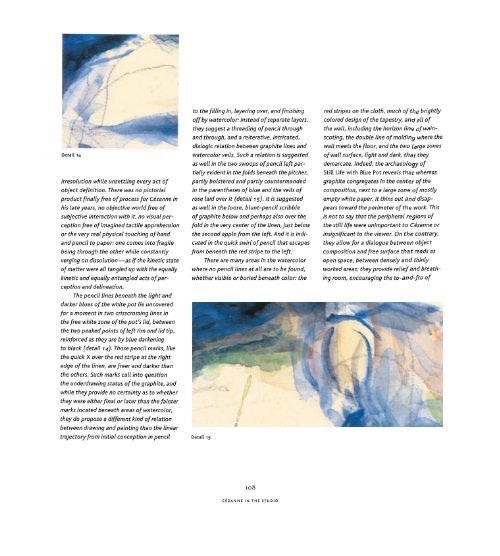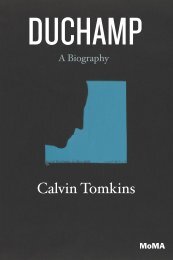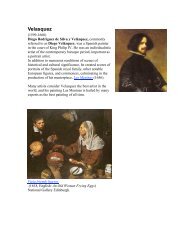Still Life in Watercolors
qbj8dgc
qbj8dgc
- No tags were found...
Create successful ePaper yourself
Turn your PDF publications into a flip-book with our unique Google optimized e-Paper software.
Detail 14<br />
irresolution while unsettl<strong>in</strong>g every act of<br />
object def<strong>in</strong>ition. There was no pictorial<br />
product f<strong>in</strong>ally free of process for Cezanne <strong>in</strong><br />
his late years, no objective world free of<br />
subjective <strong>in</strong>teraction with it, no visual perception<br />
free of imag<strong>in</strong>ed tactile apprehension<br />
or the very real physical touch<strong>in</strong>g of hand<br />
and pencil to paper: one comes <strong>in</strong>to fragile<br />
be<strong>in</strong>g through the other while constantly<br />
verg<strong>in</strong>g on dissolution—as if the k<strong>in</strong>etic state<br />
of matter were all tangled up with the equally<br />
k<strong>in</strong>etic and equally entangled acts of perception<br />
and del<strong>in</strong>eation.<br />
The pencil l<strong>in</strong>es beneath the light and<br />
darker blues of the white pot lie uncovered<br />
for a moment <strong>in</strong> two crisscross<strong>in</strong>g l<strong>in</strong>es <strong>in</strong><br />
the free white zone of the pot's lid, between<br />
the two peaked po<strong>in</strong>ts of left rim and lid tip,<br />
re<strong>in</strong>forced as they are by blue darken<strong>in</strong>g<br />
to black (detail 14). Those pencil marks, like<br />
the quick X over the red stripe at the right<br />
edge of the l<strong>in</strong>en, are freer and darker than<br />
the others. Such marks call <strong>in</strong>to question<br />
the underdraw<strong>in</strong>g status of the graphite, and<br />
while they provide no certa<strong>in</strong>ty as to whether<br />
they were either f<strong>in</strong>al or later than the fa<strong>in</strong>ter<br />
marks located beneath areas ofwatercolor,<br />
they do propose a different k<strong>in</strong>d of relation<br />
between draw<strong>in</strong>g and pa<strong>in</strong>t<strong>in</strong>g than the l<strong>in</strong>ear<br />
trajectory from <strong>in</strong>itial conception <strong>in</strong> pencil<br />
to the fill<strong>in</strong>g <strong>in</strong>, layer<strong>in</strong>g over, and f<strong>in</strong>ish<strong>in</strong>g<br />
off by watercolor: <strong>in</strong>stead of separate layers,<br />
they suggest a thread<strong>in</strong>g of pencil through<br />
and through, and a reiterative, <strong>in</strong>tricated,<br />
dialogic relation between graphite l<strong>in</strong>es and<br />
watercolor veils. Such a relation is suggested<br />
as well <strong>in</strong> the two swoops of pencil left partially<br />
evident <strong>in</strong> the folds beneath the pitcher,<br />
partly bolstered and partly countermanded<br />
<strong>in</strong> the parentheses of blue and the veils of<br />
rose laid over it (detail 15). It is suggested<br />
as well <strong>in</strong> the loose, blunt-pencil scribble<br />
of graphite below and perhaps also over the<br />
fold <strong>in</strong> the very center of the l<strong>in</strong>en, just below<br />
the second apple from the left. And it is <strong>in</strong>dicated<br />
<strong>in</strong> the quick swirl of pencil that escapes<br />
from beneath the red stripe to the left.<br />
There are many areas <strong>in</strong> the watercolor<br />
where no pencil l<strong>in</strong>es at all are to be found,<br />
whether visible or buried beneath color: the<br />
Detail 15<br />
red stripes on the cloth, much of the brightly<br />
colored design of the tapestry, and all of<br />
the wall, <strong>in</strong>clud<strong>in</strong>g the horizon l<strong>in</strong>e of wa<strong>in</strong>scot<strong>in</strong>g,<br />
the double l<strong>in</strong>e of mold<strong>in</strong>g where the<br />
wall meets the floor, and the two large zones<br />
of wall surface, light and dark, that they<br />
demarcate. Indeed, the archaeology of<br />
<strong>Still</strong> <strong>Life</strong> with Blue Pot reveals that whereas<br />
graphite congregates <strong>in</strong> the center of the<br />
composition, next to a large zone of mostly<br />
empty white paper, it th<strong>in</strong>s out and disappears<br />
toward the perimeter of the work. This<br />
is not to say that the peripheral regions of<br />
the still life were unimportant to Cezanne or<br />
<strong>in</strong>significant to the viewer. On the contrary,<br />
they allow fora dialogue between object<br />
composition and free surface that reads as<br />
open space, between densely and th<strong>in</strong>ly<br />
worked areas; they provide relief and breath<strong>in</strong>g<br />
room, encourag<strong>in</strong>g the to-and-fro of<br />
108<br />
CEZANNE IN THE STUDIO




